We shall not cease from exploration
And the end of all our exploring
Will be to arrive where we started
And know the place for the first time.
— T.S. Eliot
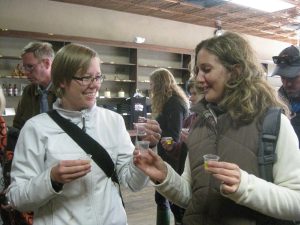 The press trip to Hocking Hills, Ohio, that I was invited to sounded like just my kind of quirky fun – visits to a washboard factory and the world’s only pencil sharpener museum, candle and pottery-making classes, off-road Segway and zipline rides, and hikes – including a haunted one at night – through unique geological formations. The trip also included experiences with spirits of this world: visits to a local craft brewery, winery, and moonshine distillery. I knew I would enjoy every aspect of the trip, but I was surprised to find that visiting Hocking Hills felt like a circling back on my life, back to the time I lived in Russia and even further back to my childhood in Scranton, Pennsylvania. I hadn’t expected to return home.
The press trip to Hocking Hills, Ohio, that I was invited to sounded like just my kind of quirky fun – visits to a washboard factory and the world’s only pencil sharpener museum, candle and pottery-making classes, off-road Segway and zipline rides, and hikes – including a haunted one at night – through unique geological formations. The trip also included experiences with spirits of this world: visits to a local craft brewery, winery, and moonshine distillery. I knew I would enjoy every aspect of the trip, but I was surprised to find that visiting Hocking Hills felt like a circling back on my life, back to the time I lived in Russia and even further back to my childhood in Scranton, Pennsylvania. I hadn’t expected to return home.
Particularly poignant for me was the visit to the town of New Straitsville, where the hills still vibrate with the echoes of coal mining, still stir in the moonlight with the secret making of corn whiskey. My Lithuanian great-grandmother made moonshine, here in America, and for me it’s always had Old World associations. I think of poverty, hardship, old ladies in head scarves muttering strange harsh languages, alienation and community, hard drinking to fortify the defenses while relaxing them. My grandmother once told me a story about dipping into the cache of moonshine that my great-grandmother stored behind the couch in the living room. My grandmother was only a little girl. She ladled out the moonshine into a cup for herself and drank it, then scooped out a cup for ‘Godmother,’ her imaginary friend – and drank that one too. She did it over and over again: “One for you, Godmother (drink), and one for me (drink).” Apparently my great-grandmother wasn’t too happy when she discovered what my grandmother was doing! I imagine my great-grandmother brought the recipe with her to America, a link to her homeland, a communal drink with strongly individual properties, forged by her personality and a longing to feel at home. That resonates with me.
I was very excited to visit a legal moonshine distillery. I’d tasted the homemade Russian version samogon (which can be any kind of self-distilled alcohol) when I was living overseas, but I’d never had any moonshine from the U.S. I’ve been on several different kinds of distillery tours and am always fascinated by them. The proprietors are masters of their craft, artists experimenting with new combinations of ingredients to create the perfect palette for their beverages. The passion infusing their explanations and their commitment to excellence inspire me to create and express. I can taste their enthusiasm and dedication in the nuances of the drink, and it’s happened several times that I was induced to buy a bottle of a spirit that before meeting the impassioned owners had seemed undrinkable to me.
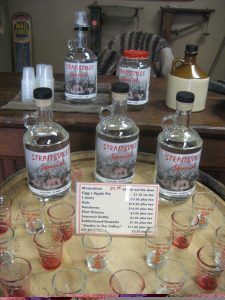 New Straitsville, a small town in the Hocking Hills region about 60 miles southeast of Columbus, was known as the bootleg capital of Ohio during Prohibition. This title was inexorably linked to the fact that it was a coal mining town, one at the center of the unrest which led to the formation of unions. In 1884, coal miners there who were angry over a labor dispute sent burning coal cars into the mine at several locations. These cars ran into a coal seam, igniting a fire that is still burning to this day. The continuous smoke provided the perfect cover for the illicit distilling. Mash barrels could be stored at a constant temperature in the mines. The spring water, flowing through the mineral-laden earth of the area, is credited with giving the moonshine its special flavor. The “Straitsville Special” became so popular during Prohibition that Al Capone supposedly got the Chicago mob involved in distributing it nationally. By the mid-1920s, modernization of mines in other areas and the ongoing labor disputes in New Straitsville left lots of unemployed coal miners who turned to moonshine production to support their families.
New Straitsville, a small town in the Hocking Hills region about 60 miles southeast of Columbus, was known as the bootleg capital of Ohio during Prohibition. This title was inexorably linked to the fact that it was a coal mining town, one at the center of the unrest which led to the formation of unions. In 1884, coal miners there who were angry over a labor dispute sent burning coal cars into the mine at several locations. These cars ran into a coal seam, igniting a fire that is still burning to this day. The continuous smoke provided the perfect cover for the illicit distilling. Mash barrels could be stored at a constant temperature in the mines. The spring water, flowing through the mineral-laden earth of the area, is credited with giving the moonshine its special flavor. The “Straitsville Special” became so popular during Prohibition that Al Capone supposedly got the Chicago mob involved in distributing it nationally. By the mid-1920s, modernization of mines in other areas and the ongoing labor disputes in New Straitsville left lots of unemployed coal miners who turned to moonshine production to support their families.
I visited Robinson’s Cave, a wide, semi-circular recess cave with amazing acoustics. Hundreds of disgruntled miners held secret meetings there, eventually resulting in the founding of the United Mine Workers. I breathed in deeply, imagining the men gathered there – full of discontent, motivated to make a difference, disconnected from the wealth and abundance of the earth’s bowels where they toiled yet aware of liberty and possibility hovering above them. I know these men; I feel their longing in the scent of the soil and decaying leaves, in my blood and bones. My grandmother’s father and husband were coal miners in Scranton, but the affinity I feel is more than genetics. I was raised in an area imbued with the energy of these men, surrounded by the sorrow of the earth, characterized by strong community bonds and considerable mistrust of outsiders. I’m sure my ancestors knew of and I imagine supported the burgeoning unions in Ohio – did they visit here? Did they know anyone who had? Even if not, I was there, completing the link of solidarity with my physical presence.
New Straitsville’s importance in the labor movement and the significance of Robinson’s Cave have been kept alive by the New Straitsville History Group, volunteers devoted to preserving the heritage of their community and honoring the dedication of the coal miners and labor leaders. I met Cheryl Blosser, the president of the Group. Her passion, an entity unto itself, lives through her, extending beyond her family ties to coal mining, smoldering continuously like the mine fire still burning in the town. Like Chris Evans, the New Straitsville labor leader she lauds so highly, she too inspires with her commitment. The memories lovingly preserved in the Group’s museum and monuments offered me the opportunity to reestablish connection with my roots, to remember who I am.
Another New Straitsville leader who struck me as not living his dream so much as being lived by his dream was Doug Nutter, the owner of Straitsville Special Moonshine Distillery. The vision he had to legally distill the corn whiskey product that had been made secretly in the hills by his family for generations – to bring moonshine out into the daylight – seemed to be pulling him forward. At New Straitsville’s annual Moonshine Festival, no moonshine had been served for over 40 years! In 2012 the laws changed, and last Memorial Day weekend, for the first time ever, the newly established Straitsville Special Moonshine Distillery was allowed to sell its corn whiskey at the event.
At the Straitsville Special store, there were pitchers used to store the moonshine, some for sale and some on display. They looked like some that my mother had from her grandmother. There were several large ones on display in the store as well as other distillery paraphernalia donated by the townspeople. We wondered whether the townspeople were upset with Doug for exposing the secrets of moonshine, and maybe some were, but he said that he had been surprised to find that the majority of people in the town were supportive, calling it “our store” and loaning items for display. Doug’s venture offered opportunities for the townspeople to reestablish their own roots and reconnect with who they are. It’s not Doug’s moonshine; it’s the community’s; it’s history’s – and it’s mine as well.
I hadn’t had moonshine since I tried the Russian version samogon, drunk straight, as a shot. I hadn’t liked it, and I didn’t think I would like moonshine. (My first experience ever being drunk was after several “7 & 7”s with Seagram’s Seven and 7Up, and I haven’t been able to drink whiskey since.) Still, I was excited to try. Doug and co-owner Amie St. Clair poured us shots of Straitsville Special and shots of pickle juice to chase them with. Russians use pickles for chasing as well, but a bite of actual pickle, not the juice. I exhaled forcefully as the Russians do and then sucked the shot down. The pickle juice chaser did help it to go down smoothly! I liked it.
I was reminded of my friends from my past in Russia, Americans and Russians, of how frequently we bonded over shots of vodka and bites of pickles or mushrooms. Life was pretty challenging for us ex-patriots there – day to day living was inherently harder than living in the US then (early to late nineties) and harder for us as foreigners. We forged connections that are still strong, still important. We struggled, cooperated, emerged victorious – gloriously victorious, as the experiences we shared living overseas were priceless. And to make the circle of nostalgia complete, Doug Nutter bears an uncanny resemblance to my Russian ex-husband.
So strange! When I first went to Russia, I hadn’t expected to find such connection, to feel so at home. And I didn’t expect to circle back and find such familiar comfort in Ohio – of my childhood home and family and one-time adopted foreign home and family. The miners in 1884 who set fire to the mines could not have known what an impact they would have – on history globally and for me personally. We really are all connected, cells that move and bump into each other setting off reactions that affect the experience of the whole.
One of the other experiences I had in Hocking Hills was candle making at The Candle Shop in Logan, Ohio. I thought we’d dip string into wax and make long candlesticks as I did once in Girl Scout camp, but actually we made candles in a jar. There were many, many scented candles that could be sampled to choose two or three aromatic oils to mix together for a custom candle. After so much time spent delving in the coal veins and mine shafts of my memory, I chose earth as my first scent. It did smell literally like fresh soil. I also chose lily of the valley and lemongrass. We carefully mixed together the essential oils in the proportions of our choice, and then they were poured into the jar with the soy base and left to cool. At first I thought I had overdone the lemongrass since it smelled a bit like furniture polish, but after it cooled completely, and the scents had settled, I liked it.
When I got back home, I had my boyfriend smell my new candle. He was flabbergasted. The smell brought him back to his grandmother’s house with a vivid sense memory. “I’m washing my hands at the sink, and I’m about to go in for a coke…” He was so obviously shaken by the experience that I gave the candle to him. What are the chances that I would make the exact scent that would so perfectly remind him of his grandmother? It turned out that my trip to Hocking Hills was a return home for him as well. Maybe on an invisible level we are all connected, all held together by a life impulse longing to express, so that wherever we go, we are always coming home.
Disclosure: My trip to Hocking Hills, OH, was made possible by the Hocking Hills Tourism Association. My opinions and perspectives are totally my own — as always.
Relevant links:
Hocking Hills Tourism Association
www.explorehockinghills.com
The Candle Shop
www.windchimeshopsales.com/candle-shop.htm

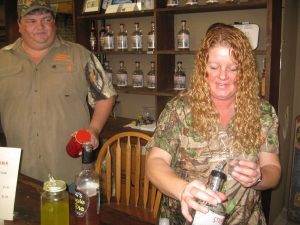
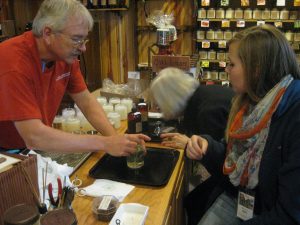

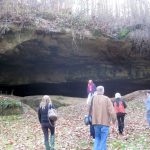
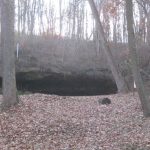



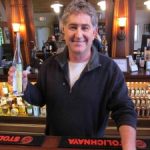


Leave a Reply